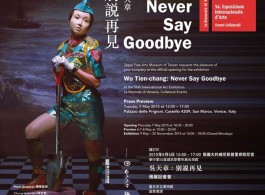‘WU Tien-chang: Never Say Goodbye’, Collateral Event of the 56th International Art Exhibition – La Biennale di Venezia opening on 7 May, 2015, will be a major solo exhibition by leading Taiwanese artist WU Tien-chang at the Palazzo delle Prigioni, a former prison inside the Palazzo Ducale. Curated by the Taipei Fine Arts Museum, the exhibition explores the atmosphere and particular sentiments of westernisation in post-war Taiwan, whilst also responding to shifts in the historical regime over the past century. Featuring three interactive video installations and two striking light box works by Taiwanese contemporary artist Wu Tien-chang, this is the first time Taiwan have presented work by a single artist at La Biennale di Venezia. The exhibition will be on view from 9 May to 22 November 2015.
Responding to the central theme of “Goodbye”, two of Wu’s recent video pieces Beloved and Unforgettable Lover, will be joined by a newly commissioned work for the Venice presentation – Farewell, Spring and Autumn Pavilions. Each of these works deals with the inevitability of sorrow and separation and feature young men and women in skin membrane costumes.

In these digital video pieces, Wu combines theatrical effects with magical tricks, handcrafted props and machine-operated scenery to surprise the viewer as the works switch from still photographs to moving images. In the newly commissioned work Farewell, Spring and Autumn Pavilions, the character chooses to wave goodbye with a springy step and a carefree manner. Along with the changing scenery and changing costumes, the character seems to say goodbye easily to the past. Actually, he is still standing in the same spot. While the external circumstances change, he himself keeps going around in circles. By shooting with a fixed camera in one take, Unforgettable Lover harks back to the handicraft era of film as the male protagonist dances to the rhythm of music while evolving into other characters by changing his clothes, sets and props in front of the audience’s eyes. In Beloved, Wu wraps the female character in a delicate latex skin to create an idealistic form of the perfect lover – amorously telling the stories of helplessness and sadness of the people coming and going from this world.
For the La Biennale di Venezia, Wu has converted two of his two-dimensional photography works into light box installations. Our Hearts Beat as One and Blind Men Groping Down the Lane are key serial works marking Wu Tien-chang’s venture into digital photography. These images are full of bright and joyful colours, but the figures captured are marginal characters with strangely proportioned bodies or disabilities.
Behind the gleeful, dazzling visuals throughout the exhibition, Wu attempts to symbolize the people of Taiwan constantly haunted by memories and nostalgia of regime changes and post-war westernisation within their society. Capturing characters in mask-like artificial skin membranes and gaudy costumes, Wu attempts to reveal the hybrid nature of Taiwanese identity and depicts the life of those in the lower classes of Taiwanese society who deeply experience the joys and sorrows of human life.
Ms. Fang Mei-ching, Chief Curator of Taipei Fine Arts Museum said, “At the show, Wu uses the flamboyant and kitsch appearances of the ghostly figures in his photography works and video installation as disguises of charm to confide in the past pains that cannot be shouldered by the individual or the entire nation. On one hand, the intricate history of post-war Taiwan is revealed, and on the other hand the romantic aspiration for the future is projected. These seemingly parallel and opposing lines have struck a balance on a perfect crossing point at the presentation, by establishing a memorable dialogue within the exhibition space and venue.”
Press Enquires
Charlotte Yip, Sutton PR Asia, charlotte@suttonprasia.com, +852 2528 0792
Chung-hsien Lin, Taipei Fine Arts Museum, walala@tfam.gov.tw, +886 2 25957656 Ext. 111
Notes to Editors
About Wu Tien Cheng
Born in 1956 in the trading port of Taiwan in Keelung, Wu is renowned for his oil paintings and digital photography, which comment on the socio-political aspect of life. Wu’s work reveals the contradictions of the photographic medium, with its apparent reality, yet often contrived and fictitious nature. Since 2000, Wu has incorporated digital retouching and image-collage techniques in his staged photography – painting backdrops, scripting, lighting, photography, making props, and directing models by himself in order to integrate the various conflicting elements into something unique and captivating. He currently lives and works in Taipei, Taiwan; his work has been shown extensively at the Taipei Fine Arts Museum, and has featured in exhibitions internationally including the Hong Kong Art Centre, Hong Kong (2010); the National Art Museum of China, Beijing, China (2009); the Taipei Cultural Center, New York (2008) and MOMA Contemporary, Fukuoka, Japan (1997).

The influences of regime changes over the past century in Taiwan
From the Japanese colony to the anti-PROC military base or even as a resting stop for American soldiers during the Cold War, Taiwan has been a transitional habitat for foreign political powers. Various cultures and products were transplanted from the motherland of these post-war foreign powers into Taiwan. As such, domestic worship of exotic goods also triggered mass production, though often poorly imitated as gaudy counterfeits. Wu was born in the thriving trading port of Keelung and witnessed the becoming and lifting of Martial Law in Taiwan. He deliberately tapped into the gaudy aesthetics of local plebeian cultures to dig out the unsightly ugly truth and scent of death lingering at the bottom society and throughout its immigration history – traumatic experiences that will continue to haunt Taiwan for years to come.
- Venue
- Taiwan in Venice 56th International Art Exhibition – La Biennale di Venezia
- Date
- 2015.05.09 Sat - 2015.11.22 Sun
- Opening Exhibition
- 05/09/2015 10:00
- Address
- Palazzo delle Prigioni, Castello 4209, San Marco, Venice, Italy
- Telephone
- Opening Hours
- Director
Wu Tien-chang: Never Say Goodbye
[Press Release]



